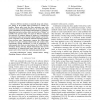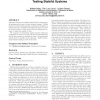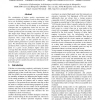168 search results - page 5 / 34 » Random testing of interrupt-driven software |
ECBS
2011
IEEE
12 years 7 months ago
2011
IEEE
Abstract—Software systems are typically large and exhaustive testing of all possible input parameters is usually not feasible. Testers select tests that they anticipate may catch...
GECCO
2009
Springer
13 years 12 months ago
2009
Springer
This paper introduces TestFul, a framework for testing stateful systems and focuses on object-oriented software. TestFul employs a hybrid multi-objective evolutionary algorithm, t...
WSC
2001
13 years 8 months ago
2001
The requirements, design principles, and statistical testing approaches of uniform random number generators for simulation are briefly surveyed. An objectoriented random number pa...
ICSE
2007
IEEE-ACM
14 years 7 months ago
2007
IEEE-ACM
Most flight software testing at the Jet Propulsion Laboratory relies on the use of hand-produced test scenarios and is executed on systems as similar as possible to actual mission...
IOLTS
2000
IEEE
13 years 11 months ago
2000
IEEE
The combination of higher quality requirements and sensitivity of high performance circuits to delay defects has led to an increasing emphasis on delay testing of VLSI circuits. A...



